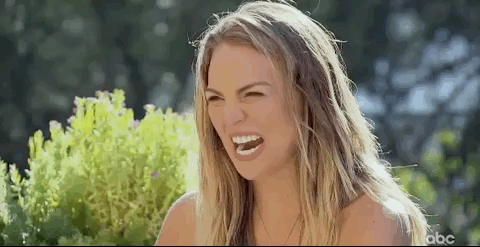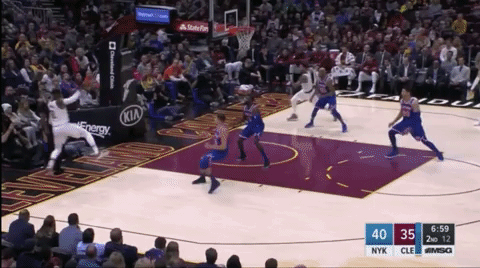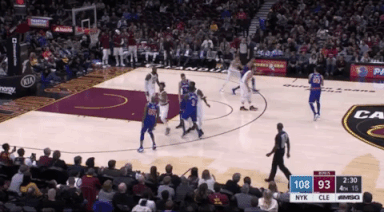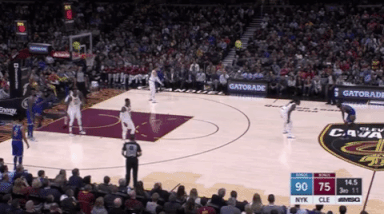It was easy to get excited about the Cavaliers this season. They brought in a band of big-name players to replace Kyrie Irving, including Dwyane Wade, Jae Crowder, Derrick Rose, Jeff Green, and Isaiah Thomas. But the Cavs dropped their third straight game Sunday, losing 114-95 to the Knicks. They’re 3-4 on the season, with the NBA’s ninth-worst net rating. Their bad start doesn’t spell total doom, but the Cavaliers have inherent issues that will lead to another NBA Finals ouster, or possibly even an earlier demise. Let’s look at the three biggest questions facing what was supposed to be the best team in the East yet again this season.
Did the Defense Get Worse?
Turns out getting older and slower doesn’t make you better, especially on the defensive end. The Cavs are now allowing 109.8 points per 100 possessions, which ranks 27th in the league (worse than the Kings and Bulls). Four players have also scored 30 points or more against the Cavaliers this season, including Kristaps Porzingis (32) and Tim Hardaway Jr. (34); no other team has allowed more than three, per Basketball-Reference.
In addition to some aging, potentially declining players on the roster, the same communication and effort problems that plagued their defense last season remain. “We’re just not talking. We’re not getting back in transition D. We’re not pointing,” Kevin Love said Sunday. Cleveland opponents are getting transition points or early offense with ease, because the team isn’t getting back into defensive stances quick enough. Here’s Tristan Thompson losing track of Porzingis:

Here’s Hardaway racing by J.R. Smith, and Courtney Lee out-sprinting both LeBron James and Kyle Korver:

“It takes trust. It takes communication. It just takes a willingness to do it,” Wade said Sunday. “We have to all get better at all those things, and that’s the only way we’re gonna win ballgames.” It has been only seven games, but you could already assemble a compilation of Cleveland transition defense lowlights. It’s not just the half court, either. Watch how Cleveland’s defense fails to keep a man on Porzingis flashing out to the arc for a wide-open 3-pointer:

Love went on to say the Cavs’ communication issues can be corrected with better effort, but that’s not entirely true. The roster is fundamentally flawed. Despite the additions of Crowder and Green, they still have too many weak spots on defense. Wade and Rose haven’t played consistently competitive defense for multiple seasons. Korver moves his legs as quickly as he can, but it’s all for naught (even rookie Frank Ntilikina drove by him with ease Sunday). Smith’s spunk wore off last season. Thompson looks complacent (on Sunday, he finished with zero boards in 19 minutes). LeBron hasn’t played regular-season defense in years, and it’s as if the rest of the roster follows his example.
Veterans Jose Calderon (36 years old) and Channing Frye (34) aren’t providing any answers, either. Neither are rookies Cedi Osman and Ante Zizic. The Little Guy, Isaiah Thomas, certainly won’t help their defensive issues, whenever he ends up returning to the floor. The bottom line is that Cleveland is old, and plays like it. Even if the Cavs begin giving effort, it’s hard to imagine that a backcourt featuring Wade, Rose, and Smith will be able to sustain that energy over a 48-minute game.
The Cavaliers need Green and Crowder to be elite defenders, especially with Giannis Antetokounmpo, John Wall, Kyrie Irving, and DeMar DeRozan blocking their path to another Finals. But they aren’t getting high-level defense from either new addition now, and they won’t going forward because neither player has that in him. In Boston, Brad Stevens constantly had to motivate Green to give consistent effort, and it came only in spurts. Crowder’s defense hasn’t been the same ever since a sprained MCL in 2015. He’s also had multiple sprained ankles over the 2015-16 and 2016-17 seasons that sapped his lateral quickness. He’s still effective against forwards, but he’s not the same player against most guards and quicker wings.

Crowder is the type of player who does better when he receives more minutes, but he’s not getting them from Tyronn Lue. Crowder has played fewer than 22 minutes four times in seven games with Cleveland, after playing fewer than 22 minutes only twice in 169 games over the past two seasons and playoffs with the Celtics.
Can Tyronn Lue Build an Offense With His New Options?
Crowder isn’t the only one struggling to adjust to a different role. Rose, Wade, Thompson, Shumpert, and Green are all playing a career-low minutes on a per-game basis. Love, Smith, and Korver are seeing near-career lows. Most of these players have found success in systems that were tailored to their strengths. But they’re now being asked to serve as ancillary options for Lue, whose lack of creativity in optimizing his other options in half-court sets isn’t helping. There’s a lot of “give the ball to LeBron and GTFO of the way,” which has made it tough for anyone else to get into a rhythm.
The Cavs are also not moving the ball as well as they did last season, partially because their spacing is suffocated by the lack of complementary playmakers. Irving is missed; so is his replacement. Getting Isaiah back will help, if he’s at least 80 percent of what he was last season and if he stays healthy (two big ifs). But he alone won’t fix Cleveland’s problems. The Cavaliers are still launching 3s (36.8 percent of their attempts are triples), but they just aren’t making as many (34.6 percent, compared with 38.4 last season). We’re working with extremely small samples, but it’s conceivable that this number will hold. They lost one of the NBA’s elite shooters in Irving and replaced him (for now, at least) with Rose (career 29.8 percent from 3) and Wade (28.7). Crowder will also need to show he can hit open 3s. He shot 43 percent from 3 on 224 attempts from last October until February, but over the rest of his career, including the playoffs, he shot 32.8 percent on 1,257 triples. It’s even more crucial that Smith find his 40-plus percent 3-point stroke and LeBron maintain his early-season hot streak (40.7 percent). Their team needs spacing to shine offensively.
As a result, it’s difficult to come up with a five-man lineup that makes sense. When the Cavs’ shooting-heavy lineups featuring Frye and Korver are on the court, they’ll struggle to defend. When their defensive-focused lineups featuring Thompson are out there, they struggle to score and space the floor. There are fewer driving lanes, which means worse ball movement. Without the ball flying around, there are fewer open shots. With fewer open shots, there are fewer makes. And with fewer makes, the opponent is able to force more transition offense down Cleveland’s throat.
The best five-man lineup for Cleveland would feature Love at center, LeBron and Crowder at forward, and Thomas and Smith in the backcourt. Smith will need to get back on track shooting the 3. Thomas will need to get healthy. So will Love, after his knee got dinged up this preseason. If the Cavaliers get a hot-shooting Crowder who plays with energy on defense, that lineup will be a force to be reckoned with. But the same isn’t true for other lineups. They still lack anyone who can stop elite perimeter scorers. Even if they get through the East, Stephen Curry and Klay Thompson will be there waiting; or James Harden and Chris Paul; or Russell Westbrook, Carmelo Anthony, and Paul George; or Kawhi Leonard.
Is There a Trade to Be Made?
Eric Bledsoe is available since the Suns banished him following his unfortunate trip to the hair salon. Bledsoe’s name has come up before in Cleveland, when the Cavs were shopping Irving. Phoenix is reportedly looking to pair Tyson Chandler’s big contract (approximately $26.6 million over this season and next) with Bledsoe to get a deal done. If the Suns are really desperate, maybe they’d take Thompson, Frye, and a future Cavaliers first-rounder. Bledsoe, a Rich Paul client with a connection to LeBron, could help solve Cleveland’s two-way issues. He could return to being the ferocious bulldog defender he once was as a young player, while also serving as a secondary playmaker alongside LeBron. It’s not hard to come up with better deals for the Suns, but they don’t have any leverage now.
Love could find himself back on the trade block. His defense has been abysmal early on. He is sluggish and lacks mobility on the perimeter and the pick-and-roll. You have to wonder if his knee is bothering him more than we know. Love had left knee surgery last season, exited a game this preseason after a left-knee injury, then fell to the ground and for a moment looked seriously injured Saturday against the Pelicans. I am skeptical about Love’s trade value anyway and wonder how much the Cavaliers could even get in return if they did shop him. Love is 29 and will be an unrestricted free agent in 2019. He hasn’t proved he can be the same player he was in Minnesota. Would a team cough up something that moves the needle for the Cavs?
It’s not as if the Nets’ unprotected 2018 first-round pick has significant value right now. Brooklyn has the same record as Cleveland and is playing tremendously gritty basketball. The Nets will be bad, but not bottom-feeders when tanking teams like the Mavericks, Hawks, and Bulls occupy the league’s basement. There isn’t even a superstar on the market that Cleveland would trade that pick for anyway, unless it flipped the panic switch and tossed it in a trade for Bledsoe. That wouldn’t be bright. The Cavs should take the long view.
That’s exactly what LeBron is doing, at least when it comes to this season. “What month is it again, October? I’m not about to go crazy over it right now. It’s too long of a season,” LeBron said Sunday. “I’ve been a part of this way too many times. I’m the wrong guy to ask. I’m too positive right now.” It’s easy to understand why LeBron isn’t panicking. It’s not even Halloween yet. He’s been on teams that have had slow starts and fired head coaches midseason and still made the NBA Finals. After all, he’s won the East seven straight years, while playing on two different teams.
But if LeBron reviews his roster through the same lens that an executive would, he’d have plenty of reason for concern. The Cavs’ personnel have fundamental issues, and their head coach is one of the least innovative minds in the league. These problems aren’t going away unless they do something about it before it’s too late.